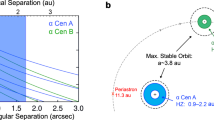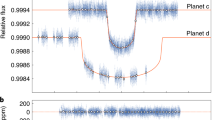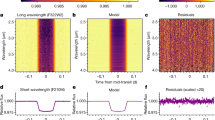Abstract
So far, around 4,000 exoplanets have been discovered orbiting a large variety of stars. Owing to the sensitivity limits of the currently used detection techniques, these planets populate zones restricted either to the solar neighbourhood or towards the galactic bulge. This selection problem prevents us from unveiling the true galactic planetary population and is not set to change for the next two decades. Here, we present a detection method that overcomes this issue and that will allow us to detect massive exoplanets using gravitational-wave astronomy. We show that the Laser Interferometer Space Antenna (LISA) mission can characterize new circumbinary exoplanets orbiting white dwarf binaries everywhere in our Galaxy—a population of exoplanets so far completely unprobed—as well as detecting extragalactic bound exoplanets in the Magellanic Clouds. Such a method is not limited by stellar activity and, in extremely favourable cases, will allow LISA to detect planets down to 50 Earth masses.
This is a preview of subscription content, access via your institution
Access options
Access Nature and 54 other Nature Portfolio journals
Get Nature+, our best-value online-access subscription
$29.99 / 30 days
cancel any time
Subscribe to this journal
Receive 12 digital issues and online access to articles
$119.00 per year
only $9.92 per issue
Buy this article
- Purchase on Springer Link
- Instant access to full article PDF
Prices may be subject to local taxes which are calculated during checkout




Similar content being viewed by others
Data availability
The data that support the plots within this paper and other findings of this study are available from the authors upon reasonable request.
References
Winn, J. N. in Handbook of Exoplanets (eds Deeg, H. J. & Belmonte, J. A.) 1949–1966 (Springer, 2018).
Fulton, B. J. et al. The California-Kepler Survey. III. A gap in the radius distribution of small planets. Astron. J. 154, 109 (2017).
Amaro-Seoane, P. et al. Laser Interferometer Space Antenna. Preprint at https://arxiv.org/abs/1702.00786 (2017).
Raghavan, D. et al. A survey of stellar families: multiplicity of solar-type stars. Astrophys. J. Suppl. 190, 1–42 (2010).
Duchêne, G. & Kraus, A. Stellar multiplicity. Annu. Rev. Astron. Astrophys. 51, 269–310 (2013).
Althaus, L. G., Córsico, A. H., Isern, J. & García-Berro, E. Evolutionary and pulsational properties of white dwarf stars. Astron. Astrophys. Rev. 18, 471–566 (2010).
Veras, D. Post-main-sequence planetary system evolution. R. Soc. Open Sci. 3, 150571 (2016).
Sigurdsson, S., Richer, H. B., Hansen, B. M., Stairs, I. H. & Thorsett, S. E. A young white dwarf companion to pulsar B1620-26: evidence for early planet formation. Science 301, 193–196 (2003).
Korol, V. et al. Prospects for detection of detached double white dwarf binaries with Gaia, LSST and LISA. Mon. Not. R. Astron. Soc. 470, 1894–1910 (2017).
Korol, V., Koop, O. & Rossi, E. M. Detectability of double white dwarfs in the local group with LISA. Astrophys. J. 866, L20 (2018).
Robson, T., Cornish, N. J., Tamanini, N. & Toonen, S. Detecting hierarchical stellar systems with LISA. Phys. Rev. D 98, 064012 (2018).
Kostov, V. B., Moore, K., Tamayo, D., Jayawardhana, R. & Rinehart, S. A. Tatooine’s future: the eccentric response of Kepler’s circumbinary planets to common-envelope evolution of their host stars. Astrophys. J. 832, 183 (2016).
Zuckerman, B., Melis, C., Klein, B., Koester, D. & Jura, M. Ancient planetary systems are orbiting a large fraction of white dwarf stars. Astrophys. J. 722, 725–736 (2010).
Veras, D. & Tout, C. A. The great escape – II. Exoplanet ejection from dying multiple-star systems. Mon. Not. R. Astron. Soc. 422, 1648–1664 (2012).
Schleicher, D. R. G. & Dreizler, S. Planet formation from the ejecta of common envelopes. Astron. Astrophys. 563, A61 (2014).
Ferrari, V., Berti, E., D’Andrea, M. & Ashtekar, A. Gravitational waves emitted by extrasolar planetary systems. Int. J. Mod. Phys. D 9, 495–509 (2000).
Berti, E. & Ferrari, V. Excitation of g-modes of solar-type stars by an orbiting companion. Phys. Rev. D 63, 064031 (2001).
Ain, A., Kastha, S. & Mitra, S. Stochastic gravitational wave background from exoplanets. Phys. Rev. D 91, 124023 (2015).
Cunha, J. V., Silva, F. E. & Lima, J. A. S. Gravitational waves from ultra-short period exoplanets. Mon. Not. R. Astron. Soc. 480, L28 (2018).
Wong, K. W. K., Berti, E., Gabella, W. E. & Holley-Bockelmann, K. On the possibility of detecting ultra-short period exoplanets with LISA. Mon. Not. R. Astron. Soc. 483, L33–L36 (2019).
Takahashi, R. & Seto, N. Parameter estimation for galactic binaries by LISA. Astrophys. J. 575, 1030–1036 (2002).
Thompson, T. A. Accelerating compact object mergers in triple systems with the Kozai resonance: a mechanism for “prompt” Type Ia supernovae, gamma-ray bursts, and other exotica. Astrophys. J. 741, 82 (2011).
Seto, N. Highly eccentric Kozai mechanism and gravitational-wave observation for neutron star binaries. Phys. Rev. Lett. 111, 061106 (2013).
Valsecchi, F., Farr, W. M., Willems, B., Deloye, C. J. & Kalogera, V. Tidally-induced apsidal precession in double white dwarfs: a new mass measurement tool with LISA. Astrophys. J. 745, 137 (2012).
Kremer, K., Breivik, K., Larson, S. L. & Kalogera, V. Accreting double white dwarf binaries: implications for LISA. Astrophys. J. 846, 95 (2017).
Breivik, K. et al. Characterizing accreting double white dwarf binaries with the Laser Interferometer Space Antenna and Gaia. Astrophys. J. 854, L1 (2018).
Nelemans, G., Yungelson, L. R. & Portegies Zwart, S. F. Short-period AM CVn systems as optical, X-ray and gravitational wave sources. Mon. Not. R. Astron. Soc. 349, 181–192 (2004).
Cutler, C. Angular resolution of the LISA gravitational wave detector. Phys. Rev. D 57, 7089–7102 (1998).
Sumi, T. et al. Unbound or distant planetary mass population detected by gravitational microlensing. Nature 473, 349–352 (2011).
Dai, X. & Guerras, E. Probing extragalactic planets using quasar microlensing. Astrophys. J. Lett. 853, L27 (2018).
Korol, V., Rossi, E. M. & Barausse, E. A multimessenger study of the Milky Way’s stellar disc and bulge with LISA, Gaia, and LSST. Mon. Not. R. Astron. Soc. 483, 5518–5533 (2019).
Luyten, W. J. White Dwarfs (Minneapolis, University of Minnesota, 1970).
Agol, E. Transit surveys for Earths in the habitable zones of white dwarfs. Astrophys. J. Lett. 731, L31 (2011).
Spalding, C., Batygin, K. & Adams, F. C. Resonant removal of exomoons during planetary migration. Astrophys. J. 817, 18 (2016).
Kostov, V. B. et al. Kepler-1647b: the largest and longest-period Kepler transiting circumbinary planet. Astrophys. J. 827, 86 (2016).
Ivanova, N. et al. Common envelope evolution: where we stand and how we can move forward. Astron. Astrophys. Rev. 21, 59 (2013).
Turrini, D., Nelson, R. P. & Barbieri, M. The role of planetary formation and evolution in shaping the composition of exoplanetary atmospheres. Exp. Astron. 40, 501–522 (2015).
Alexander, M. E., Chau, W. Y. & Henriksen, R. N. Orbital evolution of a singly condensed, close binary, by mass loss from the primary and by accretion drag on the condensed member. Astrophys. J. 204, 879–888 (1976).
Holman, M. J. & Wiegert, P. A. Long-term stability of planets in binary systems. Astron. J. 117, 621–628 (1999).
Pilat-Lohinger, E., Funk, B. & Dvorak, R. Stability limits in double stars. A study of inclined planetary orbits. Astron. Astrophys. 400, 1085–1094 (2003).
Debes, J. H. & Sigurdsson, S. Are there unstable planetary systems around white dwarfs? Astrophys. J. 572, 556–565 (2002).
Livio, M., Pringle, J. E. & Wood, K. Disks and planets around massive white dwarfs. Astrophys. J. Lett. 632, L37–L39 (2005).
Faedi, F., West, R. G., Burleigh, M. R., Goad, M. R. & Hebb, L. Detection limits for close eclipsing and transiting substellar and planetary companions to white dwarfs in the WASP survey. Mon. Not. R. Astron. Soc. 410, 899–911 (2011).
Quarles, B., Satyal, S., Kostov, V., Kaib, N. & Haghighipour, N. Stability limits of circumbinary planets: is there a pile-up in the Kepler CBPs? Astrophys. J. 856, 150 (2018).
Mustill, A. J. et al. Main-sequence progenitor configurations of the NN Ser candidate circumbinary planetary system are dynamically unstable. Mon. Not. R. Astron. Soc. 436, 2515–2521 (2013).
Portegies Zwart, S. Planet-mediated precision reconstruction of the evolution of the cataclysmic variable HU Aquarii. Mon. Not. R. Astron. Soc. 429, L45–L49 (2013).
Armano, M. et al. Sub-femto-g free fall for space-based gravitational wave observatories: LISA Pathfinder results. Phys. Rev. Lett. 116, 231101 (2016).
Armano, M. et al. Beyond the required LISA free-fall performance: new LISA Pathfinder results down to 20 μHz. Phys. Rev. Lett. 120, 061101 (2018).
Adams, D. The Hitchhiker’s Guide to the Galaxy (Pan Books, 1979).
Cornish, N. J. & Larson, S. L. LISA data analysis: source identification and subtraction. Phys. Rev. D 67, 103001 (2003).
Tokovinin, A., Thomas, S., Sterzik, M. & Udry, S. Tertiary companions to close spectroscopic binaries. Astron. Astrophys. 450, 681–693 (2006).
Pepe, F. et al. ESPRESSO: the next European exoplanet hunter. Astron. Nachr. 335, 8–20 (2014).
Tinetti, G. et al. A chemical survey of exoplanets with ARIEL. Exp. Astron. 46, 135–209 (2018).
Penny, M. T. et al. Predictions of the WFIRST microlensing survey. I. Bound planet detection rates. Astrophys. J. Suppl. Ser. 241, 3 (2019).
Lagrange, A.-M. Direct imaging of exoplanets. Phil. Trans. R. Soc. Lond. Ser. A 372, 20130090 (2014).
Beichman, C. A. et al. Imaging young giant planets from ground and space. Publ. Astron. Soc. Pac. 122, 162 (2010).
Perryman, M., Hartman, J., Bakos, G. Á. & Lindegren, L. Astrometric exoplanet detection with Gaia. Astrophys. J. 797, 14 (2014).
Althaus, L. G., García-Berro, E., Isern, J. & Córsico, A. H. Mass-radius relations for massive white dwarf stars. Astron. Astrophys. 441, 689–694 (2005).
Renedo, I. et al. New cooling sequences for old white dwarfs. Astrophys. J. 717, 183–195 (2010).
Deeg, H. J. & Alonso, R. in Handbook of Exoplanets (eds Deeg, H. J. & Belmonte, J. A.) 633–657 (Springer, 2018).
Pierens, A. & Nelson, R. P. Orbital alignment of circumbinary planets that form in misaligned circumbinary discs: the case of Kepler-413b. Mon. Not. R. Astron. Soc. 477, 2547–2559 (2018).
Foucart, F. & Lai, D. Assembly of protoplanetary disks and inclinations of circumbinary planets. Astrophys. J. 764, 106 (2013).
Martin, D. V. & Triaud, A. H. M. J. Planets transiting non-eclipsing binaries. Astron. Astrophys. 570, A91 (2014).
Martin, D. V. Circumbinary planets – II. When transits come and go. Mon. Not. R. Astron. Soc. 465, 3235–3253 (2017).
Holman, M. J. & Murray, N. W. The use of transit timing to detect terrestrial-mass extrasolar planets. Science 307, 1288–1291 (2005).
Armstrong, D. et al. Placing limits on the transit timing variations of circumbinary exoplanets. Mon. Not. R. Astron. Soc. 434, 3047–3054 (2013).
Kostov, V. B. et al. Kepler-413b: a slightly misaligned, Neptune-size transiting circumbinary planet. Astrophys. J. 784, 14 (2014).
Liu, H.-G., Wang, Y., Zhang, H. & Zhou, J.-L. Transits of planets with small intervals in circumbinary systems. Astrophys. J. 790, 141 (2014).
Hermes, J. J. et al. When flux standards go wild: white dwarfs in the age of Kepler. Mon. Not. R. Astron. Soc. 468, 1946–1952 (2017).
Sahlmann, J., Triaud, A. H. M. J. & Martin, D. V. Gaia’s potential for the discovery of circumbinary planets. Mon. Not. R. Astron. Soc. 447, 287–297 (2015).
Winget, D. E. & Kepler, S. O. Pulsating white dwarf stars and precision asteroseismology. Annu. Rev. Astron. Astrophys. 46, 157–199 (2008).
Qian, S.-B. et al. A circumbinary planet in orbit around the short-period white dwarf eclipsing binary RR Cae. Mon. Not. R. Astron. Soc. 422, L24–L27 (2012).
Beuermann, K., Dreizler, S. & Hessman, F. V. The quest for companions to post-common envelope binaries. IV. The 2:1 mean-motion resonance of the planets orbiting NN Serpentis. Astron. Astrophys. 555, A133 (2013).
Bennett, D. P. et al. The first circumbinary planet found by microlensing: OGLE-2007-BLG-349L(AB)c. Astron. J. 152, 125 (2016).
Luhn, J. K., Penny, M. T. & Gaudi, B. S. Caustic structures and detectability of circumbinary planets in microlensing. Astrophys. J. 827, 61 (2016).
Casertano, S. et al. Double-blind test program for astrometric planet detection with Gaia. Astron. Astrophys. 482, 699–729 (2008).
Sozzetti, A. et al. Astrometric detection of giant planets around nearby M dwarfs: the Gaia potential. Mon. Not. R. Astron. Soc. 437, 497–509 (2014).
Acknowledgements
We thank E. Berti, A. Buonanno, V. Korol, P.-O. Lagage, C. Miller, A. Petiteau, E. M. Rossi and G. Tinetti for their suggestions and comments. We are particularly thankful to V. Korol for providing the DWD data beyond Fig. 3 of ref. 31. C.D. acknowledges support from the LabEx P2IO, the French ANR contract 05-BLAN-NT09-573739. We acknowledge the use of the Python package mw plot (https://pypi.org/project/mw-plot/). This research has made use of the NASA Exoplanet Archive, which is operated by the California Institute of Technology, under contract with the National Aeronautics and Space Administration under the Exoplanet Exploration Program.
Author information
Authors and Affiliations
Contributions
N.T. performed the theoretical and numerical studies to produce and analyse the results presented in the paper. C.D. assessed the feasibility within the exoplanetary context, and investigated the synergies with EM observations. Both authors interpreted the results, studied the implications and wrote the paper.
Corresponding authors
Ethics declarations
Competing interests
The authors declare no competing interests.
Additional information
Peer review information: Nature Astronomy thanks Jonathan Gair and the other, anonymous, reviewer(s) for their contribution to the peer review of this work.
Publisher’s note: Springer Nature remains neutral with regard to jurisdictional claims in published maps and institutional affiliations.
Rights and permissions
About this article
Cite this article
Tamanini, N., Danielski, C. The gravitational-wave detection of exoplanets orbiting white dwarf binaries using LISA. Nat Astron 3, 858–866 (2019). https://doi.org/10.1038/s41550-019-0807-y
Received:
Accepted:
Published:
Issue Date:
DOI: https://doi.org/10.1038/s41550-019-0807-y
This article is cited by
-
Astrophysics with the Laser Interferometer Space Antenna
Living Reviews in Relativity (2023)
-
Unveiling the gravitational universe at μ-Hz frequencies
Experimental Astronomy (2021)



